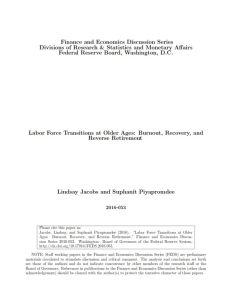Join getAbstract to access the summary!

Join getAbstract to access the summary!
Lindsay Jacobs and Suphanit Piyapromdee
Labor Force Transitions at Older Ages
Burnout, Recovery, and Reverse Retirement
Federal Reserve Board, 2016
What's inside?
How do American workers enter and exit the workforce at retirement age?
Recommendation
As American baby boomers enter their retirement years, they’re considering their options: to continue working, to take on part-time positions or to stop working altogether. In this heavily statistical analysis, economists Lindsay Jacobs and Suphanit Piyapromdee identify some noteworthy trends – including those of a “burnout-recovery process” and “reverse retirement” – that might shed light on the future retirement patterns of American workers. getAbstract suggests this scholarly report to executives looking at their workforce dynamics and to career professionals thinking about their retirement choices.
Summary
About the Authors
Lindsay Jacobs is an economist at the Federal Reserve Board. Suphanit Piyapromdee is a lecturer in economics at University College London.


















Comment on this summary